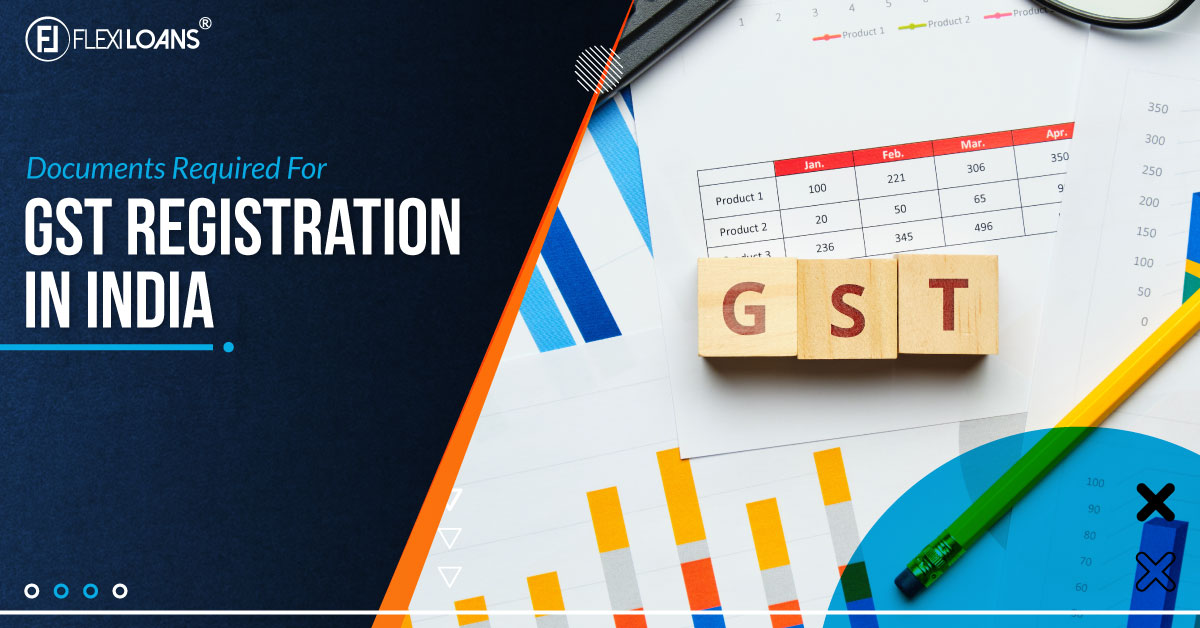Sep 29, 2021
Dec 15, 2025

GST registration entails acquiring a GSTIN from the government to collect and claim tax credits on inbound supplies. GSTIN, or GST registration number, is a unique 15-digit number assigned by the tax department to track registered taxpayers’ tax payments and compliance with applicable laws. Individuals and companies can now register for GST online, focusing on their core business without worrying about delays associated with visiting a government office. The present article will go into detail about the documentation required for GST registration.
What is the Goods and Services Tax (GST)?
When we look at the term, we see that it implies that the GST will apply to both commodities and services, resulting in a dual system of GST that allows the Central and State Governments to operate independently. The GST Council is chaired by the Union Finance Minister and includes representatives from various state governments.
Documents Required for GST Registration
The applicant must provide documents for GST registration papers that will be sent to the officials for verification for the GST Registration to be completed smoothly. The GST registration documents include the individual’s or entity’s PAN card, the business’s address or location proof, such as an Aadhar card, bank account statement, or a cancelled check, the company’s or entity’s proof of enrollment or certificate of incorporation, digital signature, the promoters’ or directors’ identity and address proofs, and a letter of approval or board resolution for the business.
GST Registration Documents List for Various Entities
Sole Proprietor/Individual
- PAN card of the owner
- Aadhar card of the owner
- Photograph of the owner
- Details of the current bank account of the owner
- Address proof of the owner
Partnership Firm (Including LLP)
- Board resolution of LLP
- Copy of document stating the appointment of authorized signatory
- Authorized signatory’s Aadhar card
- PAN card of all partners along with authorized signatory
- Address proof related to the company’s partners such as passport, voters ID, driving license, or Aadhar card
- Address proof of the firm
- Photograph of the company’s authorized signatories and core partners
- Detail of the bank account
- Partnership deed copy
Company (Public and Private)
- Photograph of authorized signatory and directors
- Authorized signatory’s required for PAN card and Aadhar card
- Proof of address and PAN card of the company’s directors
- Details of the current bank account of the owner
- MOA/AOA
- Certificate of incorporation approved by MCA
- PAN Card of the company
- Board resolution appointing authorized signatory
Society or Trust
- Address proof of the office
- Letter of authorization regarding authorized signatory
- Details of the current bank account of the owner
- Rented office NOC and rent agreement from the owner
- Photograph of promotor or partners along with PAN card
- PAN card related to society, trust, or club
- Certification related to registration
- Copy of electricity bill or property tax receipt
GST Eligibility Criteria
Before figuring out how to apply for GST, check the eligibility criteria. It is not required of those engaged in the supply of agricultural production from cultivating, the provision of solely exempt goods and services, or the provision of supplies free from the reverse charge.
Small taxpayers benefit from a lower tax burden when they register under the GST composition scheme. Individuals and businesses listed below, on the other hand, are obliged to register for GST.
- Those enrolled before the implementation of the GST
- Businesses with revenue above the stated level
- Taxable people who are non-resident Indians (NRIs)
- Entities engaged in electronic commerce or the provision of products and services through e-commerce operators
- Individuals who qualify for TDS
How to Get GST Number
GST registration in India is entirely online. The law was enacted in 2017; consequently, the government has automated its operation. The following actions must be taken to register for GST in India.
- Log Into Website: The applicant must first connect to the following website: https://www.gst.gov.in/. The applicant must next select the services option and GST registration. Following that, the applicant must select GST new registration. The applicant will be routed to the portal, which will request a login and other information.
- Fill in the Required Information: The applicant must now fill in the required information. It will comprise the business entity’s name, its kind, and its PAN number.
- Submit an Email Id and a Mobile Number: The candidate must proceed to the following stage and provide an email ID and a mobile number. All future messages will be received via the email address and cellphone number provided.
- Generate Temporary Reference Number (TRN): Once the application has entered all of the required information, an OTP (One Time Password) will be produced, and the applicant will also receive a TRN. It is referred to as the temporary reference number (TRN).
- Input Captcha Details: The following stage requires the applicant to enter the TRN and text from the displayed captcha picture. Following that, the applicant must click on continue.
- GST Registration Page: The applicant will then be routed to another website known as the GST registration page. They must state all pertinent company information. The form must also indicate the date the business was established.
- Complete the Form: All pertinent information about the promoters or directors must be included. It would apply to a sole proprietorship business. If the business is a partnership, information on the partners must be supplied. The form must include all pertinent information about the products. Any new location for the sale of products must be included on the application form.
- Upload All Required Papers: The applicant must upload all necessary business documents.
- Save and Submit an Application for ARN Number: The final step requires the applicant to save and submit the application to the appropriate authorities. The email and SMS will contain the ARN number.
GST Return Submission
All businesses operating under the GST system are required to file GST returns. Dealers who are GST registered must file annual and monthly returns, which may be conveniently done online.
A GST return is a document that provides information about a taxpayer’s income that must be filed with the relevant tax authorities to determine the amount of tax payable. A registered dealer is obliged to file GST returns containing information about their purchases, sales, output GST (on sales), and input tax credit. GSTR-1, GSTR-2, GSTR-2A, and so on are the many GST returns that taxpayers file.
Fees for GST Registration
While the Indian government does not charge for GST registration under the Goods and Services Tax (GST) system, individuals and businesses that register for GST online must pay a fee for professional services.
Penalty for Failing to Register for GST
Individuals and businesses that meet the qualifying criteria are required to register for GST. Those who violate the regulations and do not pay the tax or make partial payments (due to real mistakes) instead of full payment are subject to a penalty. Tax evasion by an offender will result in a penalty equal to 100% of the tax payable. The penalty for failing to register for GST is 10% of the entire tax owed, subject to a minimum of Rs. 10,000.
Benefits Of GST Registration
- The Emergence of a Common National Market: With the implementation of GST, registered tax assessors now pay a single, consistent tax across the country on goods and services. Additionally, GST is overseen by a Central Tax Authority known as the GST Council.
- Elimination of Taxes’ Cascading Effect: The cascading tax impact, sometimes referred to as a tax on tax, happens when a commodity is taxed at every manufacturing stage up to the point of sale to the end consumer. Each subsequent transfer of goods is taxed in addition to the taxes levied on the prior transfer.
- Exemption Limit Increased for Small Businesses and Service Providers: Previously, various indirect taxes had varied registration thresholds based on their sales volume.
- Unified Fiscal System: With GST, the government proposes to levy a single tax on all products and services supplied in the country. GST replaces many state-level taxes that previously increased the cost of goods and services while enhancing and improving the convenience of doing business.
- The Decline in the Cost of Goods: According to the GST Act, GST is levied at the point of manufacture and collected at the point of sale, which means that prices will decrease and consumers will benefit.
Conclusion
Obtaining a GST registration is required in India if you operate a business that involves exchanging goods and services. The documentation procedure is delicate in the context of GST registration. As a result, the margin of error is relatively large. Furthermore, the applicant must submit the document to the authorities via online mode.
FAQs
To complete GST registration, businesses must submit several key documents, including:
-PAN card (company’s or owner’s, depending on the business type)
-Proof of business registration (e.g., Memorandum of Association, Articles of Association)
-Authorised signatory details (PAN card, Aadhaar card and photographs)
-Address proof of the principal place of business
Sole proprietors need to provide the following GST documents:
-Owner’s PAN card and Aadhaar card
-Owner’s address proof
-Bank account details (account number, IFSC and a cancelled cheque)
In addition to the standard documents, businesses with more than one location must provide:
-Address proof of the principal place of business
-Address proof for any additional places of business
Bank account details are an essential part of the GST registration process. You’ll need to provide your account number, IFSC and a cancelled cheque to confirm the bank details for business transactions and tax filings.
Yes, having GST registration can improve your chances of getting a business loan. Many lenders, including FlexiLoans, require businesses to have GST registration to apply for MSME loans or other business loans. GST registration shows that your business is compliant with tax regulations, making it more trustworthy for lenders.
GST registration can streamline the process of applying for an MSME loan. Lenders use GST returns to assess your business’s financial health and revenue. This helps build credibility and increases the chances of quick loan approval. FlexiLoans offers fast MSME loan approvals based on minimal documentation, including GST details.
Yes, many financial institutions, like FlexiLoans, offer business loans to applicants with limited credit history. In these cases, having proper documentation, such as GST registration documents, business address proof and bank details, can enhance your application and help you secure a loan.
After completing your GST registration, you can apply for a business loan by submitting your GSTIN, financial statements and bank account details. FlexiLoans offers MSME loans with minimal documentation and quick disbursal. With GST registration, you can enhance your credibility and access collateral-free loans, helping your business grow.
Businesses can apply for GST registration through the official GST portal. You’ll need to submit the required GST registration documents, including PAN card, address proof and business registration documents. Once submitted, the application undergoes verification, and you’ll receive a GSTIN (GST Identification Number) upon approval.
Yes, a Digital Signature Certificate is mandatory for companies and LLPs when completing GST registration. It is verified electronically during the process. Sole proprietors and partnerships may not need a DSC.
Read More:
Reasons Why Your GSTIN Can Get Cancelled
The Impact Of GST On Business Loans?
Deprecated: Function get_the_author was called with an argument that is deprecated since version 2.1.0 with no alternative available. in /var/www/html/wordpress/flexiloans.com/blog/wp-includes/functions.php on line 6114
Deprecated: Function get_the_author was called with an argument that is deprecated since version 2.1.0 with no alternative available. in /var/www/html/wordpress/flexiloans.com/blog/wp-includes/functions.php on line 6114







